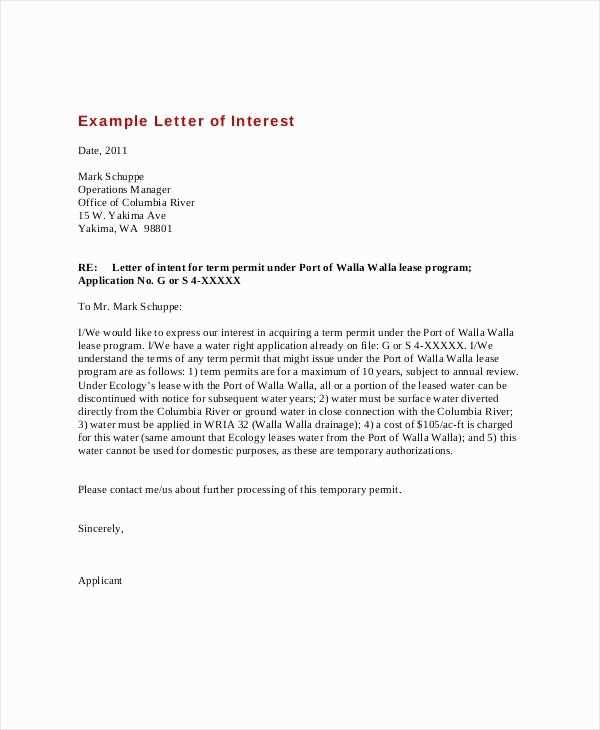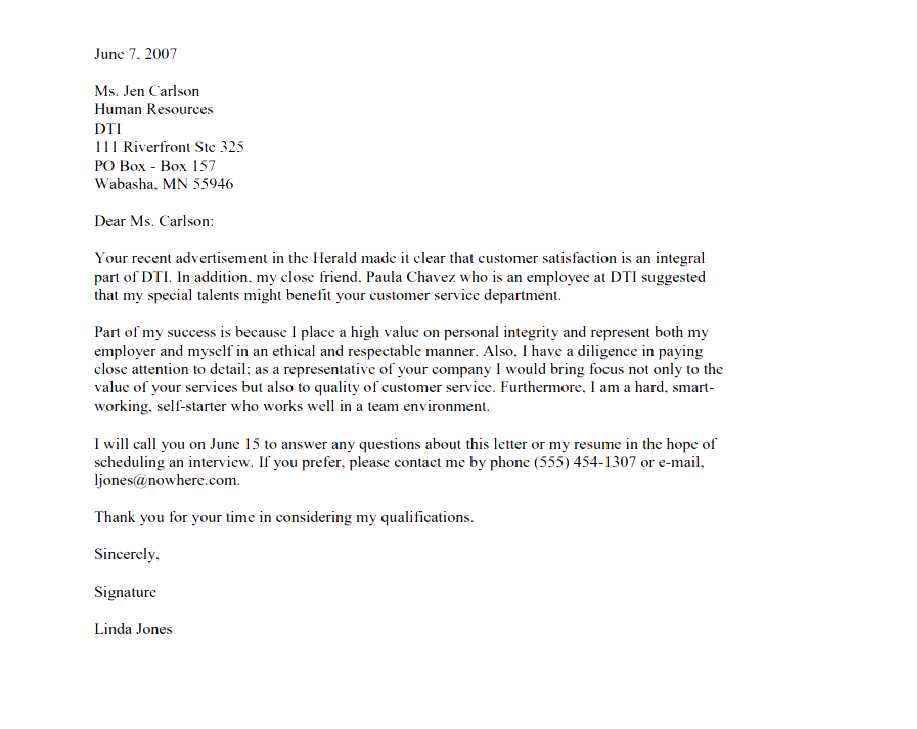Expression of interest letter template

When you are applying for a position or a project, a clear and well-structured expression of interest letter can set you apart. This letter serves as your first impression, making it crucial to demonstrate your qualifications and interest in a concise manner. Keep the tone formal, but approachable, and ensure that your letter is tailored to the specific opportunity you’re pursuing.
Start with a brief introduction, stating who you are and the purpose of your letter. Highlight your background or experience relevant to the opportunity. It’s essential to show why you are a strong candidate, giving concrete examples of your skills or achievements. Next, explain your interest in the specific position or project, demonstrating that you have done research and understand the company or initiative.
Conclude the letter with a clear statement of your desire to discuss the opportunity further. Express your willingness to provide additional information, and always remember to thank the recipient for their time and consideration. Keep the letter short, clear, and to the point.
Expression of Interest Letter Template
A well-crafted letter of interest highlights your enthusiasm and qualifications. Begin with a clear subject line to ensure the recipient understands your intent immediately. Address the letter to a specific person, if possible, using their title and last name.
In the first paragraph, introduce yourself, your current role, and the purpose of your letter. Keep it concise but direct, and mention how you learned about the opportunity or organization. For example, “I am writing to express my interest in the position of Marketing Manager, as advertised on your website.”
The second paragraph should detail your qualifications and experience. Be specific about how your skills align with the role or opportunity. Focus on concrete examples that demonstrate your abilities. Instead of general statements, mention particular achievements or projects. For example, “In my current position, I led a team that increased sales by 20% in the first quarter of this year.”
In the final paragraph, express your desire for further communication. Mention that you would appreciate the opportunity to discuss how your background and skills make you a strong fit. Close with a polite request for an interview or a meeting. Include your contact information and thank the recipient for considering your interest.
Keep your letter brief and focused. Avoid unnecessary details or lengthy explanations. A concise letter demonstrates respect for the recipient’s time and shows your ability to communicate efficiently.
Structuring the Opening of Your Letter
Begin with a clear statement of your intent. Specify the role, opportunity, or reason for your interest. A concise and direct approach is key for setting the right tone.
- Start with a formal greeting that addresses the recipient by name.
- In the first sentence, state your interest in the position or opportunity.
- Use clear and professional language to express why you are writing.
- Optionally, reference how you became aware of the opportunity, such as through a colleague, advertisement, or website.
Example: “I am writing to express my interest in the Project Manager position at XYZ Corp, which I found listed on your company’s career page.”
Keep this opening concise and focused on the purpose of your letter. Avoid unnecessary details that can distract from the main message.
Highlighting Your Qualifications and Experience

Focus on specific skills and achievements that directly align with the opportunity at hand. Clearly state the qualifications that make you a strong candidate, such as relevant certifications, degrees, or specialized training. Highlight any notable projects or roles that demonstrate your expertise and ability to deliver results in similar contexts.
Be specific about your hands-on experience, especially in areas that match the needs of the organization or project you’re interested in. Mention concrete examples of your previous work, emphasizing outcomes or improvements you’ve driven. For instance, if you led a team to successfully complete a project under tight deadlines, share measurable results like time saved or increased productivity.
Give examples of how you’ve applied your skills to solve problems or achieve objectives. Rather than simply listing duties, focus on how your approach made a difference. If you introduced a new process or system, explain how it enhanced performance or saved costs.
Connect your expertise with the requirements of the opportunity, showing how you’re prepared to contribute immediately. Avoid generic phrases and instead provide evidence of your contributions, demonstrating your value with clear, impactful statements.
Explaining Your Interest in the Opportunity

Highlight specific aspects of the opportunity that align with your goals and experience. Focus on the features that directly connect to your skills or ambitions. For example, if the opportunity offers a unique learning experience or a chance to apply your expertise in a new setting, mention how that excites you.
Linking Your Skills to the Opportunity
Identify key skills that you bring to the table and how they fit with the needs of the opportunity. Be specific about how your background prepares you to contribute effectively, whether through technical expertise, leadership, or problem-solving abilities.
Your Motivation and Long-Term Goals
Discuss how this opportunity ties into your long-term vision. Whether it’s personal growth, career advancement, or expanding your professional network, show how the opportunity aligns with your aspirations. This provides a clear context for why you’re drawn to it.
| Skill | How It Aligns |
|---|---|
| Project Management | Ability to lead cross-functional teams and meet deadlines, which is key for the role. |
| Data Analysis | In-depth knowledge of data trends that can drive insights and improve decision-making processes. |
Demonstrating Understanding of the Organization or Project
Tailor your letter by addressing specific aspects of the organization or project that align with your skills or expertise. Focus on how your experience or services directly complement their mission, goals, and values. Highlight relevant challenges they might face and show how you can offer solutions based on your past work or knowledge. Use specific examples to demonstrate your awareness of their work environment, culture, or industry position.
For instance, if the organization is focused on sustainability, mention any projects where you contributed to green initiatives or your understanding of sustainable practices. If the project involves technological development, reference any relevant technical skills or projects you have completed that showcase your proficiency in this field. This approach proves you have done your research and are genuinely interested in contributing to their objectives.
Link your experience to their goals. Mention key initiatives they are currently pursuing and demonstrate how you can help them achieve these. Be specific about how your capabilities can address their needs, whether it’s by improving a process, solving a problem, or helping them scale operations.
By demonstrating this level of understanding, you set yourself apart from others and show that you’re ready to engage with their mission from day one.
Clarifying Your Availability and Next Steps
Be clear about your availability to ensure that the recipient knows when they can expect a response from you. Specify any constraints, such as specific hours or days when you are free for follow-ups or meetings. This helps to avoid unnecessary back-and-forth and sets realistic expectations for both parties.
Availability Details
Provide specific dates and times when you are available to continue the discussion. Mention time zones if relevant, especially if communicating across different regions. If you need to align on a schedule, offer a couple of options to streamline the process.
Next Steps
Outline the expected next steps from both sides. Make sure to clarify what you need from the recipient, whether it’s additional documents, confirmation, or a meeting. Be concise, but make sure everything that is required is listed clearly to avoid confusion.
Polishing the Closing and Signature
Ensure your closing is concise and direct, leaving no room for ambiguity. A strong final paragraph reinforces your enthusiasm and reiterates why you are the right fit. Express appreciation for the reader’s time and consideration, while remaining confident and forward-looking.
1. Be Clear and Courteous
- Avoid vague phrases like “looking forward to hearing from you.” Instead, be specific: “I am eager to discuss how my skills align with your goals.”
- Thank the recipient for their time. A simple “Thank you for considering my application” works well without sounding overdone.
- Keep your tone professional but friendly, ensuring the recipient feels both respected and engaged.
2. Signing Off with Precision
- Use an appropriate sign-off such as “Sincerely,” “Best regards,” or “Kind regards,” depending on the level of formality required.
- Include your full name and, if applicable, your contact information beneath your signature. This makes it easy for the reader to reach out to you.
- If sending a hard copy, leave space for a handwritten signature, or if digital, ensure your typed name is formatted properly.